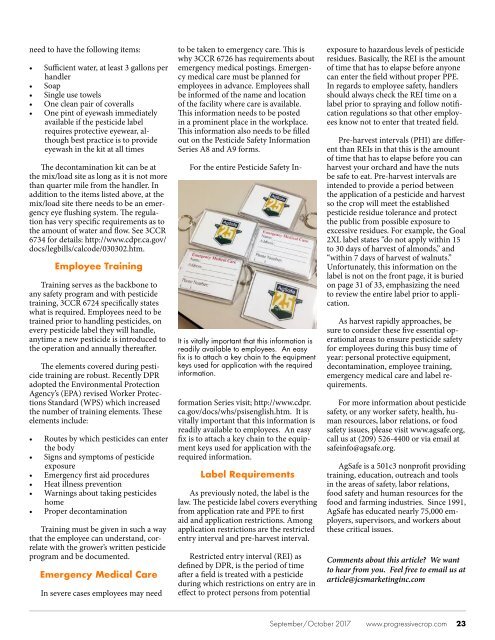September/October 2017
You also want an ePaper? Increase the reach of your titles
YUMPU automatically turns print PDFs into web optimized ePapers that Google loves.
need to have the following items:<br />
• Sufficient water, at least 3 gallons per<br />
handler<br />
• Soap<br />
• Single use towels<br />
• One clean pair of coveralls<br />
• One pint of eyewash immediately<br />
available if the pesticide label<br />
requires protective eyewear, although<br />
best practice is to provide<br />
eyewash in the kit at all times<br />
The decontamination kit can be at<br />
the mix/load site as long as it is not more<br />
than quarter mile from the handler. In<br />
addition to the items listed above, at the<br />
mix/load site there needs to be an emergency<br />
eye flushing system. The regulation<br />
has very specific requirements as to<br />
the amount of water and flow. See 3CCR<br />
6734 for details: http://www.cdpr.ca.gov/<br />
docs/legbills/calcode/030302.htm.<br />
Employee Training<br />
Training serves as the backbone to<br />
any safety program and with pesticide<br />
training, 3CCR 6724 specifically states<br />
what is required. Employees need to be<br />
trained prior to handling pesticides, on<br />
every pesticide label they will handle,<br />
anytime a new pesticide is introduced to<br />
the operation and annually thereafter.<br />
The elements covered during pesticide<br />
training are robust. Recently DPR<br />
adopted the Environmental Protection<br />
Agency’s (EPA) revised Worker Protections<br />
Standard (WPS) which increased<br />
the number of training elements. These<br />
elements include:<br />
• Routes by which pesticides can enter<br />
the body<br />
• Signs and symptoms of pesticide<br />
exposure<br />
• Emergency first aid procedures<br />
• Heat illness prevention<br />
• Warnings about taking pesticides<br />
home<br />
• Proper decontamination<br />
Training must be given in such a way<br />
that the employee can understand, correlate<br />
with the grower’s written pesticide<br />
program and be documented.<br />
Emergency Medical Care<br />
In severe cases employees may need<br />
to be taken to emergency care. This is<br />
why 3CCR 6726 has requirements about<br />
emergency medical postings. Emergency<br />
medical care must be planned for<br />
employees in advance. Employees shall<br />
be informed of the name and location<br />
of the facility where care is available.<br />
This information needs to be posted<br />
in a prominent place in the workplace.<br />
This information also needs to be filled<br />
out on the Pesticide Safety Information<br />
Series A8 and A9 forms.<br />
It is vitally important that this information is<br />
readily available to employees. An easy<br />
fix is to attach a key chain to the equipment<br />
keys used for application with the required<br />
information.<br />
For the entire Pesticide Safety Information<br />
Series visit; http://www.cdpr.<br />
ca.gov/docs/whs/psisenglish.htm. It is<br />
vitally important that this information is<br />
readily available to employees. An easy<br />
fix is to attach a key chain to the equipment<br />
keys used for application with the<br />
required information.<br />
Label Requirements<br />
As previously noted, the label is the<br />
law. The pesticide label covers everything<br />
from application rate and PPE to first<br />
aid and application restrictions. Among<br />
application restrictions are the restricted<br />
entry interval and pre-harvest interval.<br />
Restricted entry interval (REI) as<br />
defined by DPR, is the period of time<br />
after a field is treated with a pesticide<br />
during which restrictions on entry are in<br />
effect to protect persons from potential<br />
exposure to hazardous levels of pesticide<br />
residues. Basically, the REI is the amount<br />
of time that has to elapse before anyone<br />
can enter the field without proper PPE.<br />
In regards to employee safety, handlers<br />
should always check the REI time on a<br />
label prior to spraying and follow notification<br />
regulations so that other employees<br />
know not to enter that treated field.<br />
Pre-harvest intervals (PHI) are different<br />
than REIs in that this is the amount<br />
of time that has to elapse before you can<br />
harvest your orchard and have the nuts<br />
be safe to eat. Pre-harvest intervals are<br />
intended to provide a period between<br />
the application of a pesticide and harvest<br />
so the crop will meet the established<br />
pesticide residue tolerance and protect<br />
the public from possible exposure to<br />
excessive residues. For example, the Goal<br />
2XL label states “do not apply within 15<br />
to 30 days of harvest of almonds,” and<br />
“within 7 days of harvest of walnuts.”<br />
Unfortunately, this information on the<br />
label is not on the front page, it is buried<br />
on page 31 of 33, emphasizing the need<br />
to review the entire label prior to application.<br />
As harvest rapidly approaches, be<br />
sure to consider these five essential operational<br />
areas to ensure pesticide safety<br />
for employees during this busy time of<br />
year: personal protective equipment,<br />
decontamination, employee training,<br />
emergency medical care and label requirements.<br />
For more information about pesticide<br />
safety, or any worker safety, health, human<br />
resources, labor relations, or food<br />
safety issues, please visit www.agsafe.org,<br />
call us at (209) 526-4400 or via email at<br />
safeinfo@agsafe.org.<br />
AgSafe is a 501c3 nonprofit providing<br />
training, education, outreach and tools<br />
in the areas of safety, labor relations,<br />
food safety and human resources for the<br />
food and farming industries. Since 1991,<br />
AgSafe has educated nearly 75,000 employers,<br />
supervisors, and workers about<br />
these critical issues.<br />
Comments about this article? We want<br />
to hear from you. Feel free to email us at<br />
article@jcsmarketinginc.com<br />
<strong>September</strong>/<strong>October</strong> <strong>2017</strong><br />
www.progressivecrop.com<br />
23


















